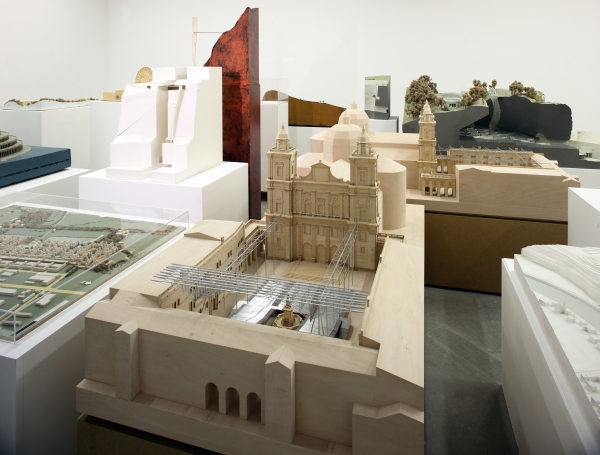Salzburg Unbuilt
Museum der Moderne, Salzburg, 28 March – 12 June 2015

Kiállítási enteriőr, az előtérben Jabornegg & Pálffy Architekten: a Dóm tér mobil tetőszerkezetének makettje, 2004
This spring the Museum der Moderne Salzburg will offer a completely new perspective of Salzburg with an exhibition devoted for the first time to rejected ideas, failed concepts, and utopian plans for this city. Over the centuries, many outstanding architects have helped to shape the city’s unique character. But their plans were not always put into practice. Research on myriad studies and competition entries has been undertaken and some thirty projects from the twentieth century onwards have been selected for this exhibition. They are thematically arranged and deal with recurrent problems and unresolved urban design issues, recalling unbuilt alternatives to the architectural reality.
Visitors are confronted by the fascinating but also oppressive question of what the city would have looked like if, for example, Vicenzo Scamozzi’s design for a cathedral in 1606 had been built instead of the much smaller version (1614–1628) by Santino Solari. How would the Salzburg Festival have turned out if Hans Poelzig’s mystic vision in 1920 for a festival hall in the grounds of Hellbrunn Palace had been adopted? The exhibition also looks at conflicting concepts and architectural ideas, such as Álvaro Siza’s suggested reconstruction of Casino Winkler (1986), Delugan_Meissl’s Panoramalift (2003) on the side of the Mönchsberg, and Hans Hollein’s epochal Guggenheim Museum (from 1989) on the same site. Thus, in this exhibition the story of Museum der Moderne Salzburg is also told.
The exhibition does not cast a nostalgic glance at missed opportunities, but rather emphasizes the freedom and significance of designs as a conception of how a city can be. At the same time, a city is far more than the sum of its buildings and projects. It is a social unit. With this in mind, the Museum der Moderne Salzburg invites everyone living in or visiting Salzburg to think about the city’s future. The diverse accompanying program offers plenty of opportunities to do so.
Salzburg Unbuilt shows projects for a city which cannot be experienced in reality. Therefore, the designs are not animated or fictionalized by digital means, but presented through historical documents. The exhibition itself may be understood as a text in which the drawings, plans, and models are the letters, the projects the words, and the thematic sections the sentences of a narrative. This text is inscribed in the museum as a storyline about the city’s history.



